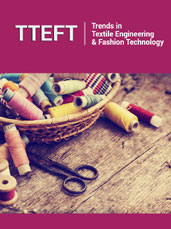- Submissions

Abstract
Trends in Textile Engineering & Fashion Technology
A Review on Bi-Component Yarn Spinning Technology (BCY) in the Global Textile Industry
-
Open or CloseÖmer Fırat Turşucular*
R&D Chief, Hatin Textile, and Hatin Tex Weaving Companies, Turkey
*Corresponding author:Ömer Fırat Turşucular, R&D Chief, Hatin Textile, and Hatin Tex Weaving Companies, DOSAB, 16245, Bursa Province, Turkey Orcid 0000-0003-1162-0742
Submission: June 24, 2024; Published: July 05, 2024

ISSN: 2578-0271Volume10 Issue2
Abstract
In this theoretical review study included its importance, formation mechanism principle, yarns used, and general properties for Bi-Component spinning technology (BCY) were explained in detail, supported by visuals, and preparing a main table from various sources. In addition, the production processes of BCY yarns and how BCY process parameters affect both the rheological, and mechanical and thermal properties of BCY yarns were explained. Finally, the effects of BCY yarn types and various process parameters on various fabric properties on textile-based woven and knitted fabric forms were explained. The purpose of this study was BCY was the optimization of the production process parameters of BCY yarn production based on yarn types by summarizing the information of various experimental studies on yarn spinning technology (BCY). The purpose of this study was BCY was the optimization of the production process parameters of BCY yarn production based on yarn types by summarizing the information of various experimental studies on yarn spinning technology (BCY). According to the results, polymers such as PLA, PHBV, PA 6, PE, PP, PET, PTT, and PBT are widely used in BCY yarn production. They can be used either 100% pure or in their mixtures with various percentages with C/S, I/S and S/S nozzle profiles. Especially, PTT/PET, and PBT/PET BCY yarns are widely used in thermal comfort behavior in textile areas for their water absorption and fast drying properties. Moreover, this thermal comfort behavior depends on the polymer type used, glass transition, crystallization and melting temperatures, percentage, viscosity, molecular weight, orientation, crystallinity, polydispersity, biological, chemical, mechanical and thermal behavior, spinneret profile, spinneret diameter, extruder temperature and extruder length/diameter ratio (L/D), length and speed of the solidification zone, the temperature of the drafting rollers, their speed and drafting rate. Although it varies depending on the polymer type, in the production of BCY yarns, generally as the temperature increases, the viscosity decreases, the fiber diameter decreases, and it becomes easier to process. Before the production of PET and its derivative polymers, it is recommended to apply the alkaline (NaOH) pretreatment process in order to reduce the fiber diameter, facilitate processing, maintain dimensional stability, reduce surface smoothness, facilitate dyeability, and improve mechanical and thermal properties. PET/PET, PA 6/PA 6, PTT/PET, PBT/PET, PET/CoPET, PET/PE, PET/PP, PET/PA 6 polymers with 40/60 and 50/50 ratios, and C/S nozzle profiles can be widely used in BCY yarn production. PP/PA 6 polymer can be also used in BCY yarn production, too. Generally, the process parameters required for BCY yarn production of PA 6, PET, CoPET, PTT, and PBT polymers are extruder ratio 1/24, internal viscosity (ŋ) range 0.62dl/g to 1.22dl/g, glass transition temperature (Tg) range 65 °C to 80 °C, crystallization temperature (Tc) 130 °C to 180 °C, melting temperature (Tm) 290 °C to 305 °C range, solidification zone from 1.5m to 3m, length, and draft ratio range from 1.5 to 3.5. The fixed temperature is recommended to be between 125 °C and 140 °C. Moreover, glass transition (Tg), crystallization (Tc), and melting (Tm) temperature values are lower in PE, PP, PLA, and PHBV polymers. PET/PE, PET/PTT, and PET/PA 6 polymers are widely used in BCY yarns thanks to their similar rheological behaviors. Recently, PLA-containing BCY yarns have started to be used, especially thanks to their biological advantages. BCY yarns containing PBT have started to be used thanks to their high maximum elongation at break and easy processability. Polymer with lower melting temperature (Tm) is generally used in the center (C) part, while polymer with higher melting temperature (Tm) is used in the shell (S) part in BCY yarns with C/S nozzle profile.
Keywords:Bi-Component Yarn Spinning Technology (BCY); Process parameters; Yarns; Fabrics; General properties
 a Creative Commons Attribution 4.0 International License. Based on a work at www.crimsonpublishers.com.
Best viewed in
a Creative Commons Attribution 4.0 International License. Based on a work at www.crimsonpublishers.com.
Best viewed in 







.jpg)






























 Editorial Board Registrations
Editorial Board Registrations Submit your Article
Submit your Article Refer a Friend
Refer a Friend Advertise With Us
Advertise With Us
.jpg)






.jpg)














.bmp)
.jpg)
.png)
.jpg)










.jpg)






.png)

.png)



.png)






